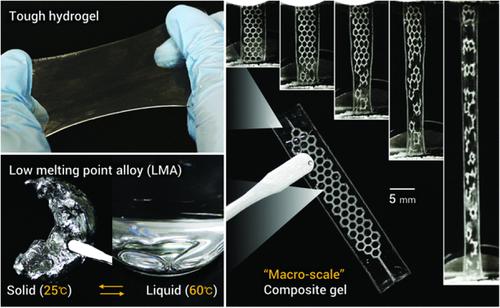当前位置:
X-MOL 学术
›
Adv. Mater.
›
论文详情
Our official English website, www.x-mol.net, welcomes your
feedback! (Note: you will need to create a separate account there.)
Creating Stiff, Tough, and Functional Hydrogel Composites with Low‐Melting‐Point Alloys
Advanced Materials ( IF 27.4 ) Pub Date : 2018-03-13 , DOI: 10.1002/adma.201706885 Riku Takahashi 1 , Tao Lin Sun 2, 3 , Yoshiyuki Saruwatari 4 , Takayuki Kurokawa 2, 3 , Daniel R. King 2, 3 , Jian Ping Gong 2, 3
Advanced Materials ( IF 27.4 ) Pub Date : 2018-03-13 , DOI: 10.1002/adma.201706885 Riku Takahashi 1 , Tao Lin Sun 2, 3 , Yoshiyuki Saruwatari 4 , Takayuki Kurokawa 2, 3 , Daniel R. King 2, 3 , Jian Ping Gong 2, 3
Affiliation

|
Reinforcing hydrogels with a rigid scaffold is a promising method to greatly expand the mechanical and physical properties of hydrogels. One of the challenges of creating hydrogel composites is the significant stress that occurs due to swelling mismatch between the water‐swollen hydrogel matrix and the rigid skeleton in aqueous media. This stress can cause physical deformation (wrinkling, buckling, or fracture), preventing the fabrication of robust composites. Here, a simple yet versatile method is introduced to create “macroscale” hydrogel composites, by utilizing a rigid reinforcing phase that can relieve stress‐induced deformation. A low‐melting‐point alloy that can transform from a load‐bearing solid state to a free‐deformable liquid state at relatively low temperature is used as a reinforcing skeleton, which enables the release of any swelling mismatch, regardless of the matrix swelling degree in liquid media. This design can generally provide hydrogels with hybridized functions, including excellent mechanical properties, shape memory, and thermal healing, which are often difficult or impossible to achieve with single‐component hydrogel systems. Furthermore, this technique enables controlled electrochemical reactions and channel‐structure templating in hydrogel matrices. This work may play an important role in the future design of soft robots, wearable electronics, and biocompatible functional materials.
中文翻译:

用低熔点合金制造硬,韧和功能性水凝胶复合材料
用刚性支架增强水凝胶是一种有前途的方法,可以大大扩展水凝胶的机械和物理性能。制备水凝胶复合材料的挑战之一是由于水溶胀的水凝胶基质与水性介质中刚性骨架之间的溶胀不匹配而产生的巨大应力。这种应力会导致物理变形(起皱,弯曲或断裂),从而阻止了坚固的复合材料的制造。在这里,介绍了一种简单而通用的方法,即通过利用可以减轻应力引起的变形的刚性增强相来创建“宏观”水凝胶复合材料。可以在相对较低的温度下从承受负载的固态转变为可自由变形的液态的低熔点合金被用作增强骨架,无论液体介质中的基质溶胀度如何,都可以释放任何溶胀失配。这种设计通常可以为水凝胶提供混合功能,包括出色的机械性能,形状记忆和热修复功能,而单组分水凝胶系统通常很难或无法实现这些功能。此外,该技术可以控制水凝胶基质中的电化学反应和通道结构。这项工作可能在软机器人,可穿戴电子设备和生物相容功能材料的未来设计中发挥重要作用。单组分水凝胶系统通常很难或不可能实现这些目标。此外,该技术可以控制水凝胶基质中的电化学反应和通道结构。这项工作可能在软机器人,可穿戴电子设备和生物相容功能材料的未来设计中发挥重要作用。单组分水凝胶系统通常很难或不可能实现这些目标。此外,该技术可以控制水凝胶基质中的电化学反应和通道结构。这项工作可能在软机器人,可穿戴电子设备和生物相容功能材料的未来设计中发挥重要作用。
更新日期:2018-03-13
中文翻译:

用低熔点合金制造硬,韧和功能性水凝胶复合材料
用刚性支架增强水凝胶是一种有前途的方法,可以大大扩展水凝胶的机械和物理性能。制备水凝胶复合材料的挑战之一是由于水溶胀的水凝胶基质与水性介质中刚性骨架之间的溶胀不匹配而产生的巨大应力。这种应力会导致物理变形(起皱,弯曲或断裂),从而阻止了坚固的复合材料的制造。在这里,介绍了一种简单而通用的方法,即通过利用可以减轻应力引起的变形的刚性增强相来创建“宏观”水凝胶复合材料。可以在相对较低的温度下从承受负载的固态转变为可自由变形的液态的低熔点合金被用作增强骨架,无论液体介质中的基质溶胀度如何,都可以释放任何溶胀失配。这种设计通常可以为水凝胶提供混合功能,包括出色的机械性能,形状记忆和热修复功能,而单组分水凝胶系统通常很难或无法实现这些功能。此外,该技术可以控制水凝胶基质中的电化学反应和通道结构。这项工作可能在软机器人,可穿戴电子设备和生物相容功能材料的未来设计中发挥重要作用。单组分水凝胶系统通常很难或不可能实现这些目标。此外,该技术可以控制水凝胶基质中的电化学反应和通道结构。这项工作可能在软机器人,可穿戴电子设备和生物相容功能材料的未来设计中发挥重要作用。单组分水凝胶系统通常很难或不可能实现这些目标。此外,该技术可以控制水凝胶基质中的电化学反应和通道结构。这项工作可能在软机器人,可穿戴电子设备和生物相容功能材料的未来设计中发挥重要作用。











































 京公网安备 11010802027423号
京公网安备 11010802027423号